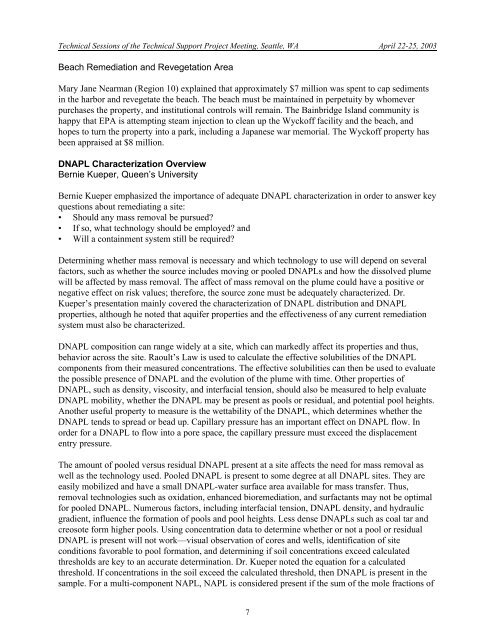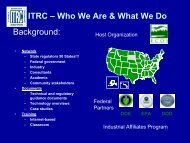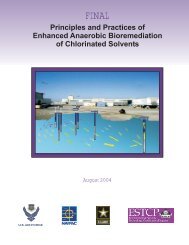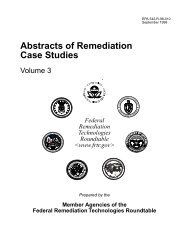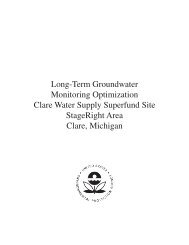Technical Sessions - Environmental Management Support, Inc.
Technical Sessions - Environmental Management Support, Inc.
Technical Sessions - Environmental Management Support, Inc.
You also want an ePaper? Increase the reach of your titles
YUMPU automatically turns print PDFs into web optimized ePapers that Google loves.
<strong>Technical</strong> <strong>Sessions</strong> of the <strong>Technical</strong> <strong>Support</strong> Project Meeting, Seattle, WA April 22-25, 2003<br />
Beach Remediation and Revegetation Area<br />
Mary Jane Nearman (Region 10) explained that approximately $7 million was spent to cap sediments<br />
in the harbor and revegetate the beach. The beach must be maintained in perpetuity by whomever<br />
purchases the property, and institutional controls will remain. The Bainbridge Island community is<br />
happy that EPA is attempting steam injection to clean up the Wyckoff facility and the beach, and<br />
hopes to turn the property into a park, including a Japanese war memorial. The Wyckoff property has<br />
been appraised at $8 million.<br />
DNAPL Characterization Overview<br />
Bernie Kueper, Queen’s University<br />
Bernie Kueper emphasized the importance of adequate DNAPL characterization in order to answer key<br />
questions about remediating a site:<br />
• Should any mass removal be pursued?<br />
• If so, what technology should be employed? and<br />
• Will a containment system still be required?<br />
Determining whether mass removal is necessary and which technology to use will depend on several<br />
factors, such as whether the source includes moving or pooled DNAPLs and how the dissolved plume<br />
will be affected by mass removal. The affect of mass removal on the plume could have a positive or<br />
negative effect on risk values; therefore, the source zone must be adequately characterized. Dr.<br />
Kueper’s presentation mainly covered the characterization of DNAPL distribution and DNAPL<br />
properties, although he noted that aquifer properties and the effectiveness of any current remediation<br />
system must also be characterized.<br />
DNAPL composition can range widely at a site, which can markedly affect its properties and thus,<br />
behavior across the site. Raoult’s Law is used to calculate the effective solubilities of the DNAPL<br />
components from their measured concentrations. The effective solubilities can then be used to evaluate<br />
the possible presence of DNAPL and the evolution of the plume with time. Other properties of<br />
DNAPL, such as density, viscosity, and interfacial tension, should also be measured to help evaluate<br />
DNAPL mobility, whether the DNAPL may be present as pools or residual, and potential pool heights.<br />
Another useful property to measure is the wettability of the DNAPL, which determines whether the<br />
DNAPL tends to spread or bead up. Capillary pressure has an important effect on DNAPL flow. In<br />
order for a DNAPL to flow into a pore space, the capillary pressure must exceed the displacement<br />
entry pressure.<br />
The amount of pooled versus residual DNAPL present at a site affects the need for mass removal as<br />
well as the technology used. Pooled DNAPL is present to some degree at all DNAPL sites. They are<br />
easily mobilized and have a small DNAPL-water surface area available for mass transfer. Thus,<br />
removal technologies such as oxidation, enhanced bioremediation, and surfactants may not be optimal<br />
for pooled DNAPL. Numerous factors, including interfacial tension, DNAPL density, and hydraulic<br />
gradient, influence the formation of pools and pool heights. Less dense DNAPLs such as coal tar and<br />
creosote form higher pools. Using concentration data to determine whether or not a pool or residual<br />
DNAPL is present will not work—visual observation of cores and wells, identification of site<br />
conditions favorable to pool formation, and determining if soil concentrations exceed calculated<br />
thresholds are key to an accurate determination. Dr. Kueper noted the equation for a calculated<br />
threshold. If concentrations in the soil exceed the calculated threshold, then DNAPL is present in the<br />
sample. For a multi-component NAPL, NAPL is considered present if the sum of the mole fractions of<br />
7


